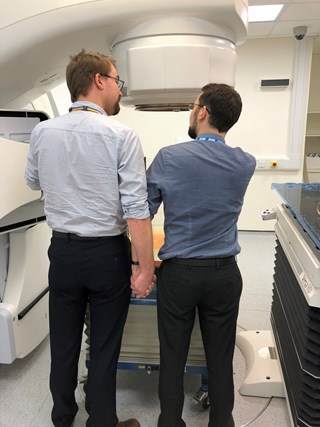Day 3
The September 1969 edition of the Health Physicists’ Association Newsletter, in the library at the IPEM National Office in York, makes no mention of the events, described in Monday’s blog, that had occurred earlier that summer in New York, but it does have an interesting article on SCRAP, a system for computing radiotherapy treatment plans.
The first thing to note from yesterday’s blog with respect to Medical Physics, Clinical Engineering and STEM in general is that there are actually queer medical physicists and clinical engineers. It’s true, there are. This might sound obvious, but it wasn’t until two or three years ago that I had any evidence that I wasn’t the only LGBTQ+ person in the profession. In many ways this shouldn’t matter, as a common view is that sexuality and to some extents gender identity have nothing to do with the professional Medical Physics environment.
Having thought about this for some time, I would argue to the contrary that these things are absolutely fundamental to the core identity of a person and affect the clothes we wear, the personal things we keep around us and how we interact with our colleagues. If we work in an environment that is consistent with our identities, then we don’t notice the fact that these characteristics follow us everywhere we go; but if there are inconsistencies we start to pay attention.
What happens when an LGBTQ+ person finds themselves in a cis-straight environment will very much depend on the individual, the environmental culture and their external support networks. In some cases, often in the major cities where there are strong LGBTQ+ communities, an individual may be content to come out and be themselves from their very first day.
In smaller regional communities, however, LGBTQ+ people can feel a strong sense of isolation, whether or not they are out at work, simply because they are in an environment where they don’t know of anyone else like them. In the worst case scenario they simply don’t come out at work and that in turn reduces their productivity and has a negative impact on their mental health. The problem is that despite the numerous equality and diversity policies in place, the vast majority of STEM workplaces are overtly cis-gender and heteronormative, particularly in the physical sciences and engineering.[1]

In Medical Physics and Clinical Engineering it would appear that we do somewhat better at equality and diversity than the physical sciences in general, as a recent article in IPEM’s Scope magazine on gender balance in Medical Physics pointed out.[2] That is not to say that we don’t have much still to do, but my own experience would suggest that overt bi-, trans- or homophobia from colleagues in the workplace is a pretty rare occurrence; though unconscious microaggressions can be more common and also have a considerable detrimental effect on individuals experiencing them. In Medical Physics and Clinical Engineering, not only do we have to support our LGBTQ+ colleagues, but we also have to support our LGBTQ+ patients.
Recent reports have shown that LGBT patients can encounter discrimination and abuse from their health providers and that 1 in 7 LGBT people have avoided treatment for fear of this.[3] It is clear that those of us working in healthcare that are directly patient facing have a large role to play in improving the current situation, but there are also roles for those in academia and industry.
For instance, how often do we consider the full range of gender identities when designing patient questionnaires and audits? When we introduce ourselves to patients our colleagues, do we tell them our own preferred pronouns? Do we implicitly assume that a patient’s or colleague’s partner is of the opposite sex, unless corrected? When we write software, do we assume a binary gender identity and then apply filters according to the gender selected? LGBTQ+ patients can encounter specific health issues: remember, some trans men have ovarian cancer. Most of all, when we ask for patient opinions on our services, do we include the full diversity of patients in our involvement groups, including LGBTQ+ patients? Because, when making decisions that affect LGBTQ+ people it is really important that their voices are heard and their lived experiences understood.
In Thursday’s blog I’ll look at how LGBTQ+ have made their voices heard and become more visible as Pride has evolved over the years
[1] There are a few studies reports on this subject, two that may be of interest are the joint House of Commons and InterEngineering report, “Engineering Action: Tackling Homophobia in Engineering” by A. Shelbrooke and M. McBride-Wright, 2015 and the American Physical Society, 2016 report “LGBT Climate in Physics: Building an Inclusive Community”.
[2] E. Aristovich, P. Marsden & H. Williams, “A summary of discussions on gender equality: what is medical physics doing right?” IPEM SCOPE, Volume 28 Issue 1, March 2019.
[3] Stonewall UK & YouGov LGBT in Britain Health Report, 2018.
Image credit: https://www.nature.com/news/excluded-intimidated-and-harassed-lgbt-physicists-face-discrimination-1.19614